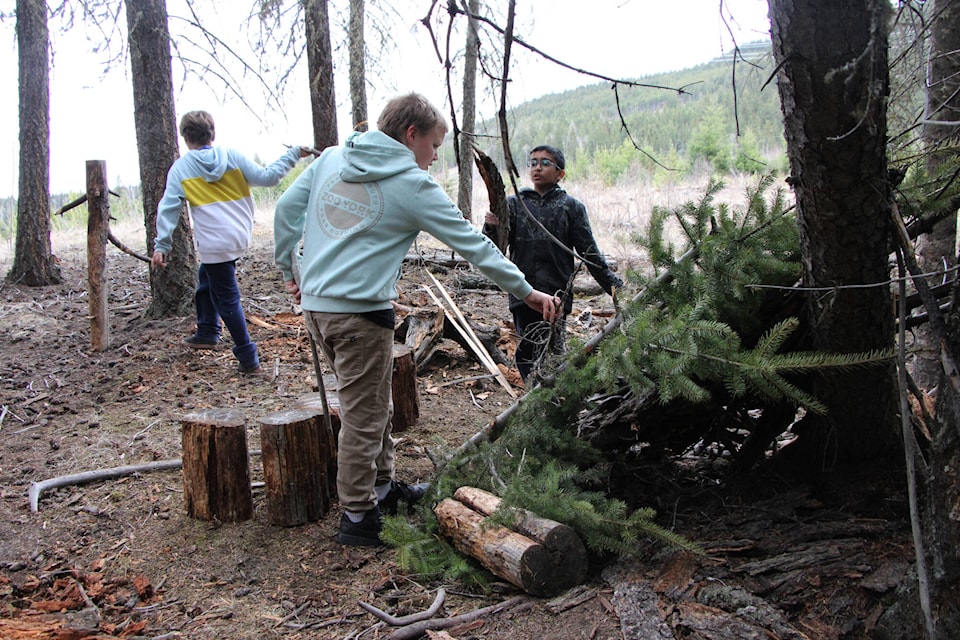Once a week on Thursday afternoons Amy Simcox’s Grade 5/6 class’ classroom becomes the forest.
Since before Spring Break the 100 Mile Elementary School teacher has been taking her students to a patch of forest above Centennial Park near the foot of the old ski hill. There she lets her students build forts, play and learn about the natural world.
“We came up here and it was kind of an Applied Design, Skills and Technology (ADST) project about building things and they just really got into it. The outdoors is super important for all kids,” Simcox said, noting she incorporates different aspects of the curriculum into their outings. “ADST is a new course they introduced a couple of years ago and it’s fun.”
Simcox said that this approach to learning also plays to her strengths, specifically her ecology degree. As part of her degree, she studied herbaceous plants meaning she can often identify the plants her students find and share interesting pieces of trivia with them.
Peyton Adams-Simpson, Grade 5, said she really enjoys getting a chance to get out of the classroom and learn in nature. Getting some fresh air and connecting with the real world is important to her.
“You get to breathe the fresh air instead of sitting inside and breathing everybody else’s air you breathe the Mother Nature air,” Peyton said. “It gets you in the real world instead of technology and stuff in the classroom. Technology isn’t the whole world. Being outside is better than being on my phone the whole time.”
Simcox noted she makes sure her students all leave their phones back in the classroom when they head out to the woods. That way she said her students can socialize, with even her most challenging students working together. She noted they also have the freedom to be as loud as they want and just “be kids” in the forest.
“I find that when we can get out (like this) they do so much better in the classroom setting when we’re there. They are able to focus better on their Math and English,” Simcox explained.
When it came to building her fort Peyton and her friends chose an old fallen tree and began building a roof over top of it using sticks and branches. She said they plan to divide it up into little rooms with each girl getting their own bedroom, a workshop and a meeting area. Peyton said her only complaint was that the boundaries set by Simcox put certain “beautiful sticks” beyond her reach.
Anthony Jongbloets, Grade 6, meanwhile, delights in making his own sticks by snapping off deadfall from fallen trees. Together with his friends, he built a fort called Fort Nugget 2.0.
“We found bark, sticks and a lot of that stuff. We start with sticks to build the structure then we put logs on top of it,” Anthony explained. “I like building the fort and breaking the sticks, it’s cool.”
Building forts isn’t the only thing Simcox has her students doing outside. Earlier this month she had them out collecting compost to revitalize one of the school’s old flower beds. She said they plan to turn the plot into a native garden with local flowers and plants, using funding from a grant she secured with Kindergarten teacher Tammi Varney.
To that end, when they visit their forts over the next few weeks, Simcox plans to have her students collect samples of the local plants so they can later plant them in their garden.
“We’re trying to do that in a very ecologically friendly way and try to mimic it and go from there,” Simcox said.
Peyton said her class is already trying to make the dirt for their garden mimic samples Simcox took from the area where they’re building their forts. Using compost from the 100 Mile Community Garden, she said they mixed in wood chips they made from logs found in the forest and some mulch.
The class’s goal this year is to build up the soil. In addition to the compost from the community garden, Simcox plans to set up a class worm composter so they can provide their own. This year they’ll be growing some wildflowers in the garden with a goal to plant more native plants next year. Varney’s kindergarten class, who are raising butterflies this year, will also be able to release them into the garden.
“Native plants are adapted to live in these conditions so they don’t need a lot of water which is important with the conditions we have going on. They’re also usually traditional plants that First Nations people use for a variety of reasons,” Simcox said. “We also want to green up our space (at school) so we can help mitigate climate change.”
